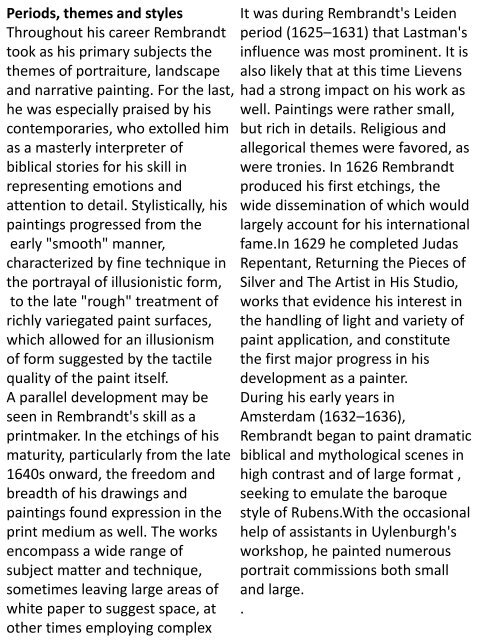Aziz Art January2018
History of art(west and middle east)- contemporary art
History of art(west and middle east)- contemporary art
Create successful ePaper yourself
Turn your PDF publications into a flip-book with our unique Google optimized e-Paper software.
Periods, themes and styles<br />
Throughout his career Rembrandt<br />
took as his primary subjects the<br />
themes of portraiture, landscape<br />
and narrative painting. For the last,<br />
he was especially praised by his<br />
contemporaries, who extolled him<br />
as a masterly interpreter of<br />
biblical stories for his skill in<br />
representing emotions and<br />
attention to detail. Stylistically, his<br />
paintings progressed from the<br />
early "smooth" manner,<br />
characterized by fine technique in<br />
the portrayal of illusionistic form,<br />
to the late "rough" treatment of<br />
richly variegated paint surfaces,<br />
which allowed for an illusionism<br />
of form suggested by the tactile<br />
quality of the paint itself.<br />
A parallel development may be<br />
seen in Rembrandt's skill as a<br />
printmaker. In the etchings of his<br />
maturity, particularly from the late<br />
1640s onward, the freedom and<br />
breadth of his drawings and<br />
paintings found expression in the<br />
print medium as well. The works<br />
encompass a wide range of<br />
subject matter and technique,<br />
sometimes leaving large areas of<br />
white paper to suggest space, at<br />
other times employing complex<br />
It was during Rembrandt's Leiden<br />
period (1625–1631) that Lastman's<br />
influence was most prominent. It is<br />
also likely that at this time Lievens<br />
had a strong impact on his work as<br />
well. Paintings were rather small,<br />
but rich in details. Religious and<br />
allegorical themes were favored, as<br />
were tronies. In 1626 Rembrandt<br />
produced his first etchings, the<br />
wide dissemination of which would<br />
largely account for his international<br />
fame.In 1629 he completed Judas<br />
Repentant, Returning the Pieces of<br />
Silver and The <strong>Art</strong>ist in His Studio,<br />
works that evidence his interest in<br />
the handling of light and variety of<br />
paint application, and constitute<br />
the first major progress in his<br />
development as a painter.<br />
During his early years in<br />
Amsterdam (1632–1636),<br />
Rembrandt began to paint dramatic<br />
biblical and mythological scenes in<br />
high contrast and of large format ,<br />
seeking to emulate the baroque<br />
style of Rubens.With the occasional<br />
help of assistants in Uylenburgh's<br />
workshop, he painted numerous<br />
portrait commissions both small<br />
and large.<br />
.


















